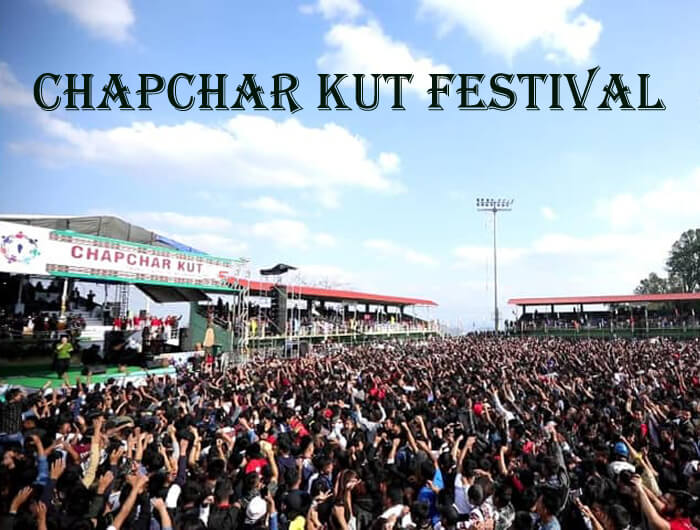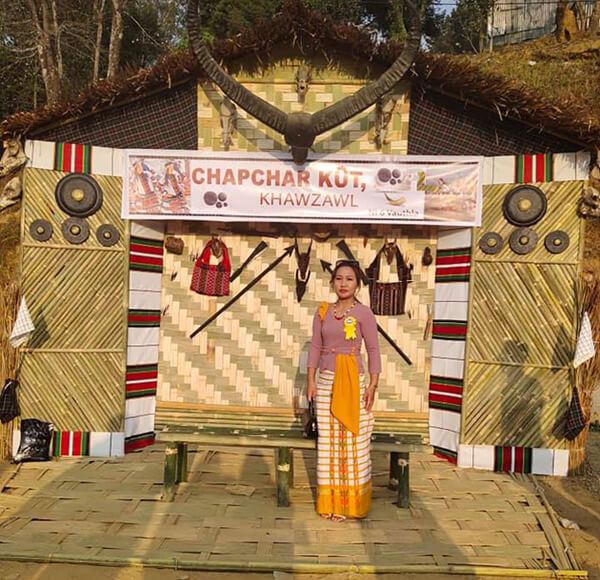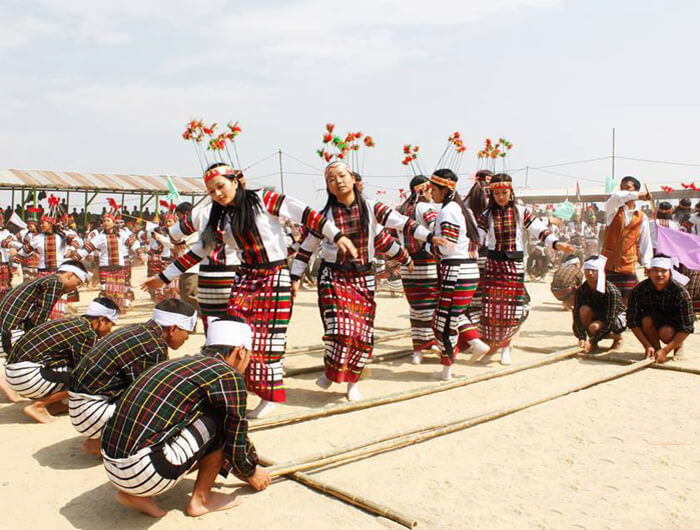Chapchar Kut

Chapchar Kut is one of the major harvest festivals of Mizoram and is named after the bamboo that are cut and dried during that time. The word ‘Chapchar’ means drying bamboo sticks and ‘kut‘ means festival. It is the most colorful festival celebrated by everyone in the state no matter to what age, gender, and community they belong.
March is the time when bamboo forests are cut to provide space for seasonal farming. After the Jhum operation i.e. cleaning of the jungle it’s time to celebrate the spring festival with great fervor and gaiety. The start of the spring season marks the end of the harvesting season and the beginning of the new cultivation season hence the time is celebrated with a festival. The bamboo dance ‘Cheraw’ is a big part of the festival.
In 2025 Chapchar Kut will be celebrated on Friday, March 7th.
In Aizwal, the capital of Mizoram, the festival is also celebrated as a giant carnival. Chapchar Kut is also celebrated in many other parts of the world where Mizo have migrated and settled.
History of Chapchar Kut
Chapchar Kut is estimated to have started in 1450-1700 A.D. in Suaipui village in Myanmar, where the Mizo population was huge. As done by many hill tribes, the Mizo practice “an agricultural technique which involves cutting and burning of forests or woodlands” so that space is created for the cultivation of hill paddy and vegetables.
When English missionaries came to Mizoram in the late 1890s, they discouraged the festival citing detrimental to Christian values. However, it was revived in 1973 on a mass scale.
The cutting of the forest is usually done during the later part of December or early January. The trees and bamboo which have been cut are allowed to dry for some time during which the villagers do not have much to do. They go hunting and fishing, sharpen their tools and celebrate Chapchar Kut.
Activities during the festival

During the week-long festival, both men and women can be seen wearing their traditional dress, jewelry, and headgear. Dance and music competitions are an integral part of the Chapchar Kut festival in Mizoram.
Various folk dances are performed along with long bamboo staves. These dances are very colorful and distinctive which require a lot of skill and coordination. Each tribal group takes great pride in presenting its own form of traditional dance and songs. During this festival dance like Khullam, Chheihlam, Chai, and Sarlamknce performance are also enjoyed.
Mizoram traditional games and costume parades also occur. Tourist attractions like food festivals, flower shows, music competitions, and exhibitions of handicrafts and handlooms of the state are organized during Chapchar Kut.
Cheraw dance

Little is known about the origin of Cheraw. The dance is unique, elegant, and spectacular, but it carries a deeper connection to the land and the lives of the people. Possibly the forefathers of Mizos brought it with them when they left their homes in far-east Asia. Cheraw is performed on any occasion during the festival. It is a dance of sanctification and redemption performed with great care, precision, and elegance.
Cheraw dance is characterized by the use of bamboo staves, which are kept in cross and horizontal positions on the ground. It mainly consists of mostly six to eight people holding pairs of bamboo staves upon another horizontally placed bamboo on the ground.
The male dancers move these bamboo staves in rhythmic beats and the female dancers perform by stepping in and out of the bamboo blocks. Finally, the Cheraw at Chapchar Kut subtly and intricately epitomizes cultural connections and values. The group dance celebrates the spirit of the community Mizoram is famous for and the bamboo attests to the connection to forest and land. The circular dance within the bounds of the bamboo seemingly reflects the rotational system of Jhum cultivation itself.
Significance
This harvest festival is named after bamboo that is cut and dried in fields. The most arduous task of the Jhum operation. Chapchar Kut used to be celebrated to thank the gods for saving the people from harm during the clearing of forest on hill slopes for Jhum cultivation at the beginning of a year. Farmers have to wait for bamboo to dry so in their free time they celebrate the event with dances and feasting.
Suggested Read: List Of Festivals Celebrated In The Month Of March






